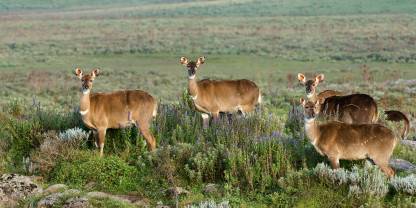Average Expert Rating
Rating Breakdown
Write a User ReviewEthiopian wolves on Sanetti Plateau
The main reason I wanted to go to Sanetti Plateau in Bale Mountains was to photograph the endemic Ethiopian wolf, the rarest canine in the world. I knew these dog-like creatures live at very high altitudes and I imagined my journey would involve some serious mountain climbing. Little did I know that the highest all-weather road in Africa would take us right across the Afro-montane moorland of the 4,200m/13,779ft high plateau. Getting up a mountain this high by road feels like cheating, but I wasn’t about to complain; a little stroll around the picnic site left me gasping for oxygen. The otherworldly habitat of Erica-covered moorland dotted with giant lobelias is worth the trip in itself, but we were rewarded with some very special wolf sightings. I saw several individuals trot across the plateau in search of their prey, the endemic giant mole rat. And when dusk rolled in, pack members grouped together for an elaborate greeting ceremony.
The land of the wolf…
The best place to see the Ethiopian wolves is on the Sanetti Plateau, but be warned – it is bitterly cold! Because there are so few wolves, I had doubted we’d see any when we visited, but while we were looking through binoculars to one wolf in the distance, another came and sat right next to our Land Rover, watching us quietly and full of curiosity, and so close I could have stroked him.
Some of Bale’s 78 mammal species and 310 species of birds can only be found here, like the handsome mountain nyala, the skittish Menelik’s bushbuck and the
Read more
weird giant mole-rat (a favorite meal for the wolf). And black-maned lions, giant forest hogs and an unusual black leopard have been spotted in the mystical, lichen-draped Harenna Forest.Wolves, Jungles, & a Snowy Plateau
There are weird giant lobelia plants growing in stands around icy lakes and ponds, and there are mists and clouds and strange-colored lichens clinging to rocks.
I’ll never forget the time I found myself up to my ankles in snow, breathing heavily in the thin air as a pair of critically endangered Ethiopian wolves commenced hunting rodents mere meters from where I stood.
It was literally breathtaking.
There are probably fewer than 400 of these persecuted canids left in existence, but chances of encountering one whilst up on the Sanetti Plateau are surprisingly high.
Read more
Bale Mountains National Park also includes the low-lying Harenna forests where one can encounter hundreds of bird species as well as the endemic Bale monkey, and various rare frogs and reptiles. There’s also a beautiful, often misty, band of juniper forest, found mostly between 2,500m and 3,300m, where mosses and ferns drape from strange twisty trees.
Multiple visits
Read more
throws up sightings of the dark-maned Abyssinian race of lion and giant forest hog. And I’d concur fully with the African Birding Club’s assessment of Bale as the continent’s fourth-best birding site, on account of the exceptional wealth of endemics and raritiesamong the 310 species recorded. Forest birds abound at Dinsho and Harena, while the lakes that stud the Sanetti Plateau often attract the likes of Rouget’s rail, blue-winged goose, ruddy shelduck, wattled crane and spot-breasted plover. Bale offers some great opportunities for hiking, but its main habitats are all accessible by car (ideally 4x4), with Sanetti being traversed by the highest all-weather road in Africa.
Stronghold of the Ethiopian wolf
Over and above the wild Alpine scenery, Bale’s premier attraction is the relative ease with which you can see up to a dozen endemic birds, as well as Ethiopian wolves and mountain nyala. In my experience, the spectacular Sanetti Plateau at sunrise is consistently the best place to spot endangered Ethiopian wolves. And in contrast to Webb Valley, the other prime wolf habitat, Sanetti has yet to be invaded by people.
Unfortunately, the park is under
Read more
increasing threat from human encroachment, livestock and feral dogs that harass and frequently kill the wolves through competition for food or by spreading disease – predominantly rabies and canine distemper – into the wolf population. The Ethiopian Wolf Conservation Programme does an admirable job of trying to vaccinate and protect the wolves, but the pressures and challenges are unrelenting.The well-maintained trails of the Bale Mountains National Park are perfect for multiday hiking and horseback riding. Your trek – whether on foot or horseback – will take you on an attractive weeklong circuit across an undulating plateau peppered with numerous glacial lakes, wetlands and rocky ridges. The desolate plateau looks like a moonscape. Often cloaked in swirling mist, with the ethereal howls of wolves, it exudes a strong sense of wilderness, while the park’s southern slopes are covered by the lush and largely unexplored Harenna Forest where lions persist along with giant forest hogs.
Bale Mountains is the ultimate safari destination for nature enthusiasts, intrepid hikers, horseback safari lovers, endemic wildlife seekers and seasoned twitchers (birdwatchers).
The wolves’ last stand
Read more
more than worthwhile.The biggest surprise wasn’t so much the wolves and mountain grandeur, but the lower slopes of the park where twisted goblin-like forests dominate, lions can occasionally be seen (but don’t come here expecting a Serengeti-like lion encounter) and it’s possible to walk over hot golden-grass savannah as hundreds of Bohor reedbuck, Menelik’s bushbuck and even the occasional towering mountain nyala graze unconcerned a few dozen metres away.
Bale won’t appeal to everyone, but for those who relish in getting off the beaten track and walking through stunning, wildlife-busy mountainscapes, this is easily the best national park in Ethiopia.
THE place to see the Ethiopian Wolf
In the juniper forest on the foothills, you should hopefully see the mountain nyala and Menelik’s bushbuck, and endemic bird specials such as Abyssian catbird, black-headed siskin and white-backed black tit. Make sure you schedule enough time to visit both these very different habitats in Bale.

